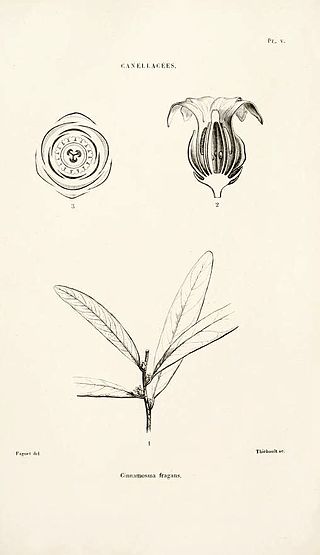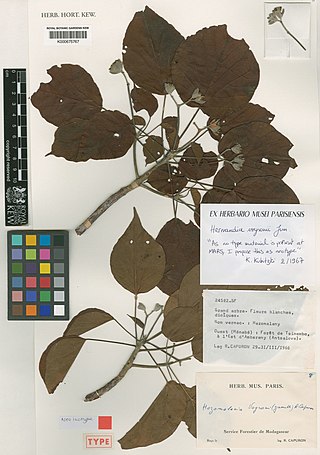Kaliphora madagascarensis is a species of evergreen shrub or small tree. It is endemic to Madagascar, where it inhabits subhumid woodlands and forests in eastern Madagascar, in the provinces of Antananarivo, Antsiranana, Fianarantsoa, and Mahajanga.
Leptolaena abrahamii is a species of flowering plant in the family Sarcolaenaceae. It is found only in Madagascar. Its natural habitat is mid-elevation humid tropical forests. It is threatened by habitat loss.

Dypsis basilonga is a species of flowering plant in the family Arecaceae. It is endemic to Madagascar. It grows in humid, mossy habitat on mountains. It is threatened by overharvesting.
Dypsis ligulata is a species of flowering plant in the family Arecaceae. It is found only in Madagascar. It is threatened by habitat loss.

Dypsis mananjarensis is a species of flowering plant in the family Arecaceae. It is found only in Madagascar. It is threatened by habitat loss.
Dypsis nauseosa is a species of flowering plant in the family Arecaceae. It is found only in Madagascar. It is threatened by habitat loss.

Dypsis onilahensis is a species of palm tree in the family Arecaceae. It is endemic to Madagascar as is reflected in the species name (onilahensis) referring to the Onilahy River, south of Toliara. It is threatened by habitat loss.

Dypsis rivularis is a species of flowering plant in the Arecaceae family. It is palm endemic to Madagascar, where it grows in forests near rivers. It is threatened by habitat loss. There are fewer than 100 mature individuals estimated to remain.

Dypsis sahanofensis is a species of flowering plant in the family Arecaceae. It is found only in Madagascar. It is threatened by habitat loss.

Lemurophoenix halleuxii is a species of palm tree, the only species in the genus Lemurophoenix. It is found only in Madagascar. It is threatened by habitat loss and overcollection. There are perhaps 300 mature individuals remaining in the wild.
Melanophylla alnifolia is a species of plant in the Torricelliaceae family. It is endemic to eastern Madagascar. Its natural habitat is tropical moist lowland and montane forests. It is threatened by habitat loss.
Astropanax myrianthus is a species of plant in the family Araliaceae. It is a tree, shrub, or liana native to Madagascar and the Comoro Islands.

Cinnamosma fragrans is a species of flowering plant in the family Canellaceae. It is endemic to Madagascar, where it is commonly known as saro.
Cinnamosma madagascariensis is a species of flowering plant in the family Canellaceae. It is endemic to Madagascar., where it is known as sakaihazo.
Gereaua is a monotypic genus of flowering plants belonging to the family Sapindaceae. It only contains one species, Gereaua perrieri.
Pilgerina is a monotypic genus of flowering plants belonging to the family Santalaceae. It only contains one known species, Pilgerina madagascariensis.

Salvadoropsis is a monotypic genus of flowering plants belonging to the family Celastraceae. It only contains one known species, Salvadoropsis arenicola.
Humbertiodendron is a monotypic genus of flowering plants belonging to the family Trigoniaceae. The only species is Humbertiodendron saboureaui.
Ephippiandra tsaratanensis is a species of flowering plant endemic to the Tsaratanana Massif of northern Madagascar.

Hernandia voyronii, commonly known as Hazomalany, is a species of plant in the Hernandiaceae family. It is endemic to Madagascar.










